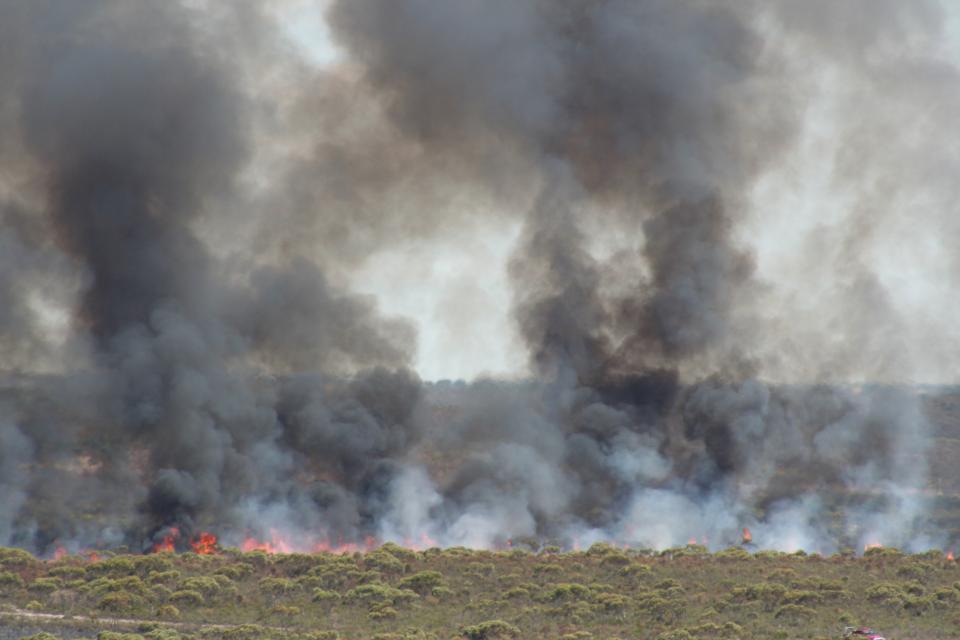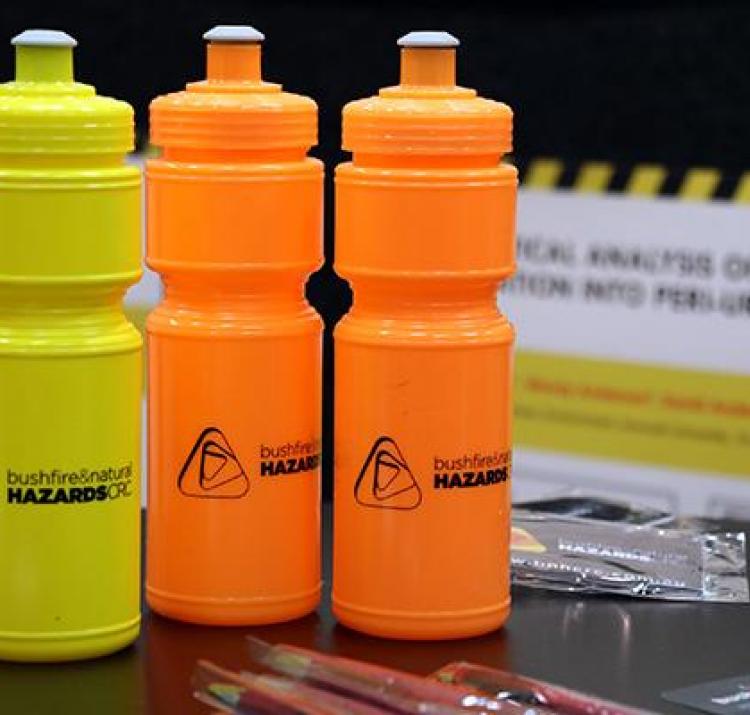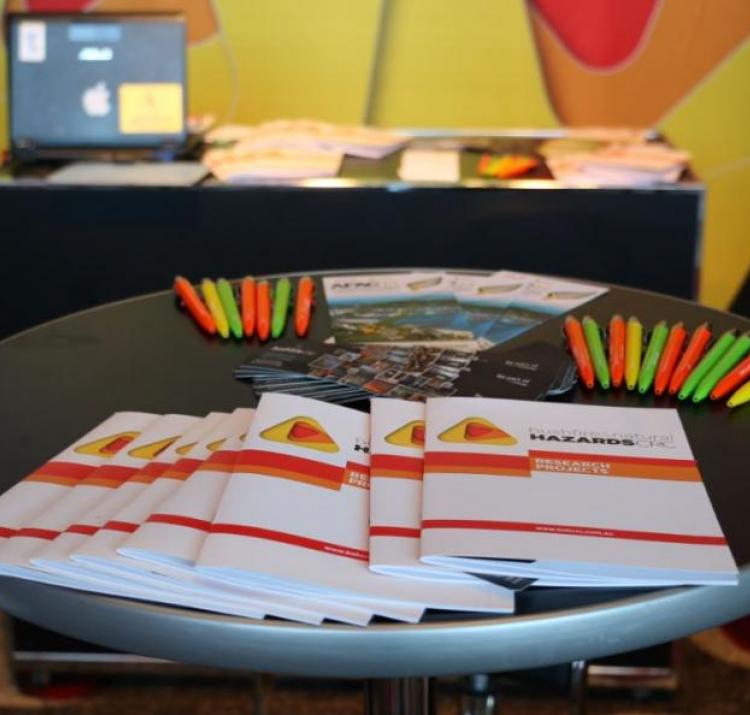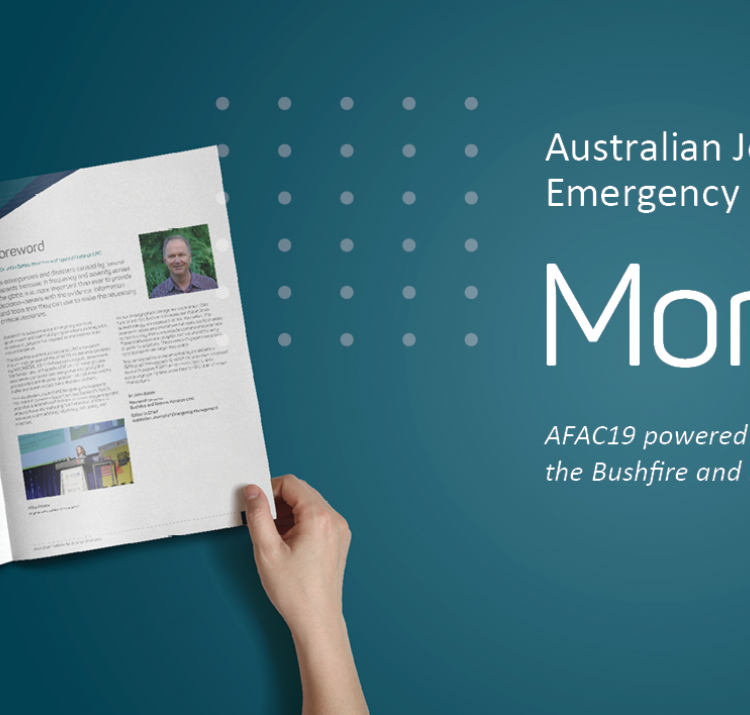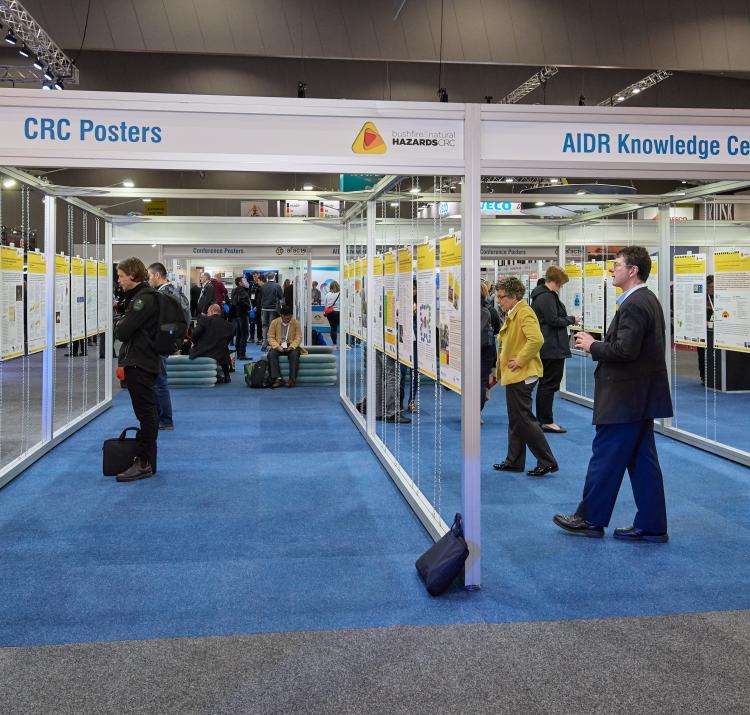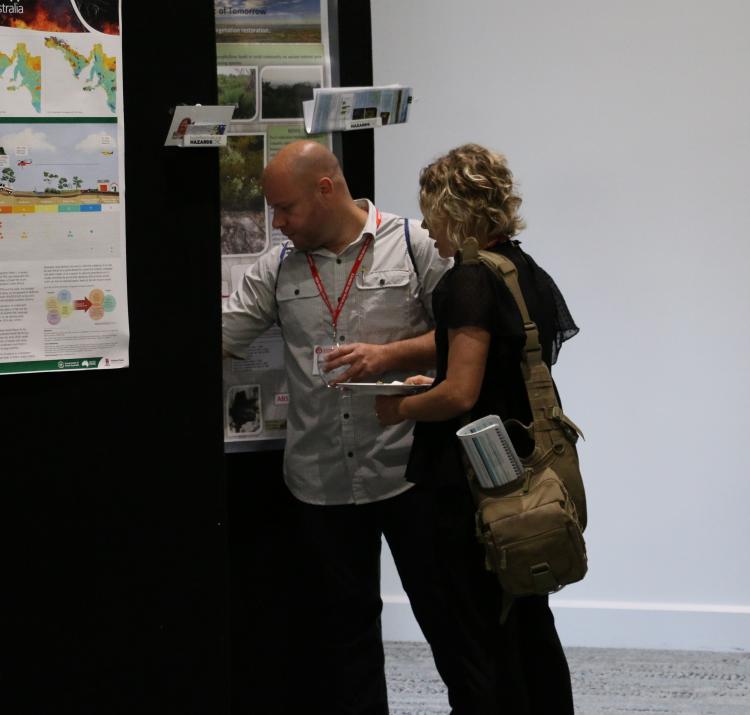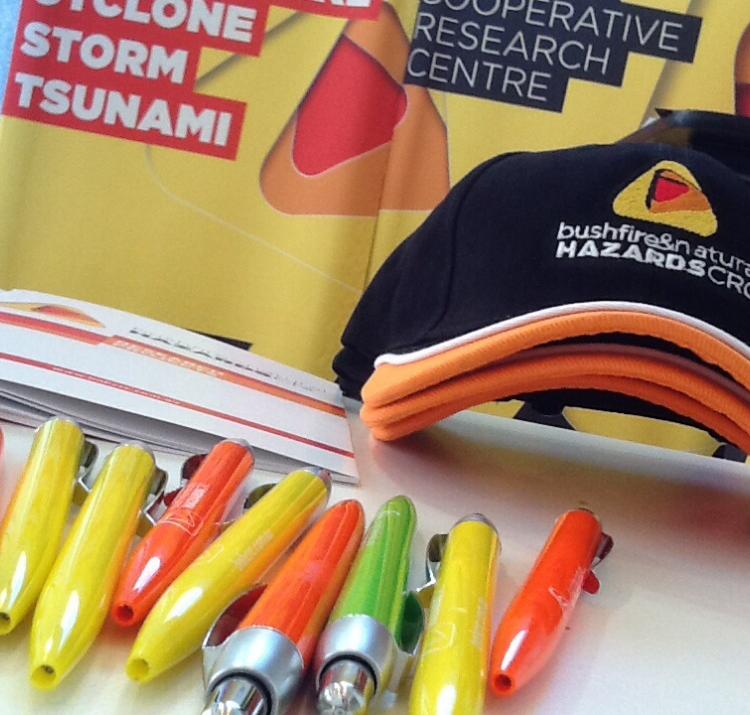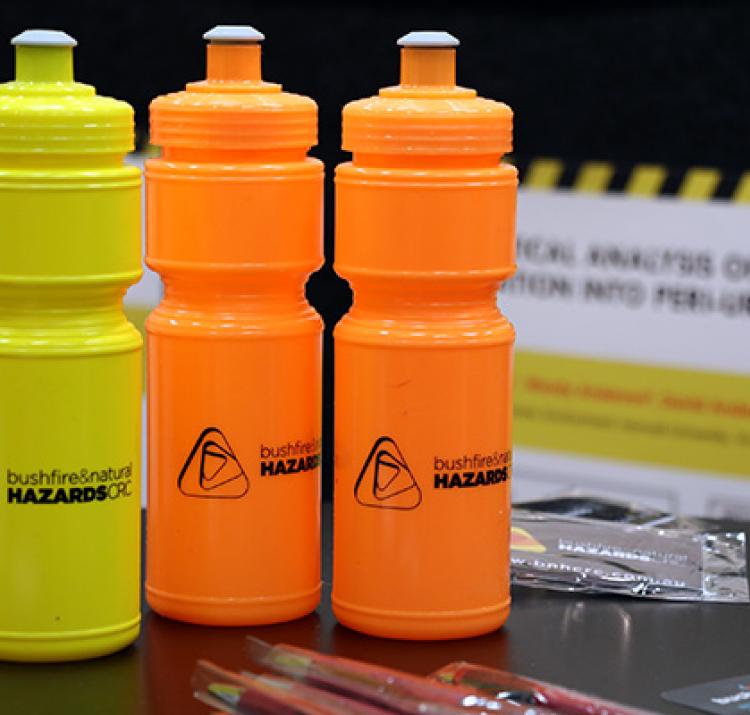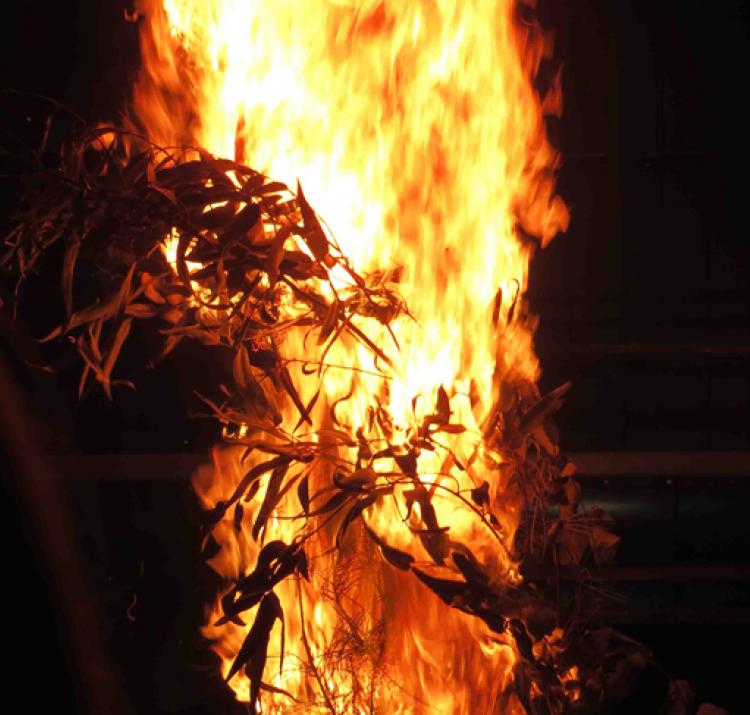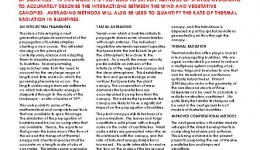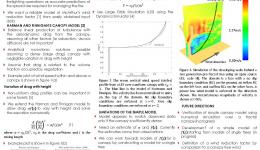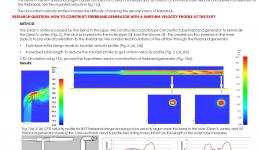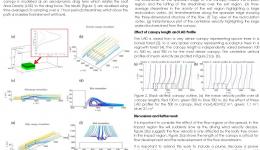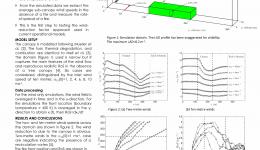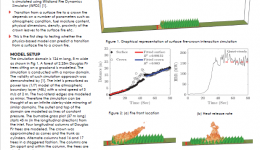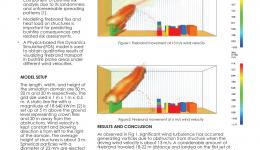|
2023 |
Journal Article |
Innocent, J., Sutherland, D., Khan, N. & Moinuddin, K. Physics-based simulations of grassfire propagation on sloped terrain at field scale: flame dynamics, mode of fire propagation and heat fluxes. International Journal of Wildland Fire (2023). doi:https://doi.org/10.1071/WF21125 |
|
2023 |
Journal Article |
Sutherland, D., Rashid, M., Hilton, J. & Moinuddin, K. Implementation of spatially-varying wind adjustment factor for wildfire simulations. Environmental Modelling & Software 163, 105660 (2023). |
|
2023 |
Journal Article |
Khan, N., Sutherland, D. & Moinuddin, K. Simulated behaviour of wildland fire spreading through idealised heterogeneous fuels. International Journal of Wildland Fire (2023). doi:https://doi.org/10.1071/WF22009 |
|
2023 |
Journal Article |
Hassan, A., Accary, G., Sutherland, D. & Moinuddin, K. Physics-based modelling of junction fires: Parametric study. International Journal of Wildland Fire (2023). at <https://www.publish.csiro.au/WF/justaccepted/WF22121> |
|
2023 |
Journal Article |
Innocent, J., Sutherland, D., Khan, N. & Moinuddin, K. Physics-based simulations of grassfire propagation on sloped terrain at field scale: motivations, model reliability, rate of spread and fire intensity. International Journal of Wildland Fire (2023). doi:https://doi.org/10.1071/WF21124 |
|
2022 |
Journal Article |
Wadhwani, R., Sutherland, D., Ooi, A. & Moinuddin, K. Firebrand transport from a novel firebrand generator: numerical simulation of laboratory experiments. International Journal of Wildland Fire 31, (2022). |
|
2022 |
Journal Article |
Wadhwani, R. et al. A review of firebrand studies on generation and transport. Fire Safety Journal 134, (2022). |
|
2022 |
Journal Article |
Wickramasinghe, A., Khan, N. & Moinuddin, K. Determining firebrand generation rate using physics-based modelling from experimental studies through inverse analysis. Fire 5, (2022). |
|
2021 |
Journal Article |
Moinuddin, K., Khan, N. & Sutherland, D. Numerical study on effect of relative humidity (and fuel moisture) on modes of grassfire propagation. Fire Safety Journal (2021). doi:https://doi.org/10.1016/j.firesaf.2021.103422 |
|
2021 |
Journal Article |
Sutherland, D., Sharples, J. J., Mell, W. & Moinuddin, K. A response to comments of Cruz et al. on: ‘Simulation study of grass fire using a physics-based model: striving towards numerical rigour and the effect of grass height on the rate of spread’. International Journal of Wildland Fire (2021). doi:https://doi.org/10.1071/WF20091 |
|
2021 |
Report |
Rashid, M. & Moinuddin, K. Studying leaf area density based wind adjustment factor in Spark. (Bushfire and Natural Hazards CRC, 2021). |
|
2021 |
Report |
Khan, N., Wickramasinghe, A., Rashid, M. & Moinuddin, K. Fire spread across different fuel types: research and utilisation – final project report. (Bushfire and Natural Hazards CRC, 2021). |
|
2020 |
Journal Article |
Accary, G. et al. Physics-Based Simulations of Flow and Fire Development Downstream of a Canopy. Atmosphere 11, (2020). |
|
2020 |
Report |
Khan, N., Sutherland, D. & Moinuddin, K. Recirculation regions downstream of a canopy on a hill. (Bushfire & Natural Hazards CRC, 2020). |
|
2020 |
Report |
Rashid, M., Sutherland, D. & Moinuddin, K. Fire spread prediction across fuel types: annual report 2018-19. (Bushfire and Natural Hazards CRC, 2020). |
|
2020 |
Report |
Khan, N., Sutherland, D. & Moinuddin, K. Simulation of flows through canopies with varying atmospheric stability. (Bushfire and Natural Hazards CRC, 2020). |
|
2020 |
Report |
Moinuddin, K., Khan, T. & Sutherland, D. Effect of relative humidity on grassfire propagation. (Bushfire and Natural Hazards CRC, 2020). |
|
2020 |
Report |
Wickramasinghe, A., Khan, N. & Moinuddin, K. Physics-based simulation of firebrand and heat flux on structures in the context of AS3959. (Bushfire and Natural Hazards CRC, 2020). |
|
2020 |
Report |
Rashid, M., Hilton, J., Khan, N., Sutherland, D. & Moinuddin, K. A report on WRF software development (preliminary). (Bushfire & Natural Hazards CRC, 2020). |
|
2019 |
Conference Paper |
Parker, J. & Allen, A. Utilisation of fire spread simulators to assess power network fire risk . AFAC19 powered by INTERSCHUTZ - Bushfire and Natural Hazards CRC Research Forum (Australian Institute for Disaster Resilience, 2019). at <https://knowledge.aidr.org.au/resources/australian-journal-of-emergency-management-monograph-series/> |
|
2019 |
Conference Paper |
Moinuddin, K. & Sutherland, D. Simulations of radiation heat flux on a structure from a fire in an idealised shrubland . Bushfire and Natural Hazards CRC Research Day AFAC19 (2019). at <https://knowledge.aidr.org.au/resources/australian-journal-of-emergency-management-monograph-series/> |
|
2019 |
Journal Article |
Sutherland, D., Sharples, J. J. & Moinuddin, K. The effect of ignition protocol on grassfire development. International Journal of Wildland Fire 29, 70-80 (2019). |
|
2019 |
Journal Article |
Moinuddin, K. & Sutherland, D. Modelling of tree fires and fires transitioning from the forest floor to the canopy with a physics-based model. Mathematics and Computers in Simulation (2019). doi:https://doi.org/10.1016/j.matcom.2019.05.018 |
|
2019 |
Journal Article |
Khan, N., Sutherland, D., Wadhwani, R. & Moinuddin, K. Physics-Based Simulation of Heat Load on Structures for Improving Construction Standards for Bushfire Prone Areas. Frontiers in Mechanical Engineering 5, (2019). |
|
2019 |
Report |
Khan, N., Sutherland, D., Philip, J., Ooi, A. & Moinuddin, K. A preliminary report on simulation of flows through canopies with varying atmospheric stability. (Bushfire and Natural hazards CRC, 2019). |
|
2018 |
Conference Paper |
Sutherland, D., Wadhwani, R., Philip, J., Ooi, A. & Moinuddin, K. Simulations of the effect of canopy density profile on sub-canopy wind speed profiles. AFAC18 (Bushfire and Natural Hazards CRC, 2018). |
|
2018 |
Conference Paper |
Bates, J. Research proceedings from the 2018 Bushfire and Natural Hazards CRC and AFAC Conference. Bushfire and Natural Hazards CRC & AFAC annual conference 2017 (Bushfire and Natural Hazards CRC, 2018). |
|
2018 |
Conference Paper |
George, N., Philip, J. & Ooi, A. Direct Numerical Simulation of Confined Wall Plumes. 21st Australasian Fluid Mechanics Conference (2018). at <https://people.eng.unimelb.edu.au/imarusic/proceedings/21/Contribution_790_final.pdf> |
|
2018 |
Journal Article |
Moinuddin, K., Sutherland, D. & Mell, W. Simulation study of grass fire using a physics-based model: striving towards numerical rigour and the effect of grass height on the rate of spread. International Journal of Wildland Fire 27, 800-814 (2018). |
|
2018 |
Report |
Moinuddin, K., Roy, S. Singha, Sutherland, D. & Khan, N. Improvements to wind field generation in physics-based models to reduce spin-up time and to account for terrain, heated earth surface. (Bushfire and Natural Hazards CRC, 2018). |
|
2018 |
Report |
Sutherland, D., Wadhwani, R., Philip, J., Ooi, A. & Moinuddin, K. Simulations of the effect of canopy density profile on sub-canopy wind speed profiles. (Bushfire and Natural Hazards CRC, 2018). |
|
2018 |
Report |
Sutherland, D., Philip, J., Ooi, A. & Moinuddin, K. Literature review: modelling and simulation of flow over tree canopies. (Bushfire and Natural Hazards CRC, 2018). |
|
2017 |
Conference Paper |
Sutherland, D., Moinuddin, K. & Ooi, A. Large-eddy simulation of neutral atmospheric surface layer flow over heterogeneous tree canopies. AFAC17 (Bushfire and Natural Hazards CRC, 2017). |
|
2017 |
Conference Paper |
Rumsewicz, M. Research proceedings from the 2017 Bushfire and Natural Hazards CRC and AFAC Conference. Bushfire and Natural Hazards CRC & AFAC annual conference 2017 (Bushfire and Natural Hazards CRC, 2017). |
|
2017 |
Journal Article |
Wadhwani, R., Sutherland, D., Ooi, A., Moinuddin, K. & Thorpe, G. Verification of a Lagrangian particle model for short-range firebrand transport. Fire Safety Journal 91, 776-783 (2017). |
|
2017 |
Journal Article |
Wadhwani, R., Sutherland, D., Moinuddin, K. & Joseph, P. Kinetics of pyrolysis of litter materials from pine and eucalyptus forests. Journal of Thermal Analysis and Calorimetry (2017). doi:10.1007/s10973-017-6512-0 |
|
2017 |
Report |
Moinuddin, K. & Sutherland, D. Numerical modelling of fires on forest floor and canopy fires. (Bushfire and Natural Hazards CRC, 2017). |
|
2016 |
Journal Article |
MacDonald, M., Chan, L., Chung, D., Hutchins, N. & Ooi, A. Turbulent flow over transitionally rough surfaces with varying roughness densities. Journal of Fluid Dynamics October 2016, (2016). |
|
2016 |
Report |
Moinuddin, K., Sutherland, D. & Thorpe, G. Fire spread prediction across fuel types: Annual project report 2015-2016. (Bushfire and Natural Hazards CRC, 2016). |
|
2015 |
Presentation |
Chung, D. et al. The spread of fires in landscapes. (2015). |
|
2015 |
Report |
Thorpe, G. Fire spread prediction across fuel types: Annual project report 2014-2015. (Bushfire and Natural Hazards CRC, 2015). |
|
2015 |
Report |
Thorpe, G. Fire Spread Across Fuel Types Annual Report 2014. (2015). |

